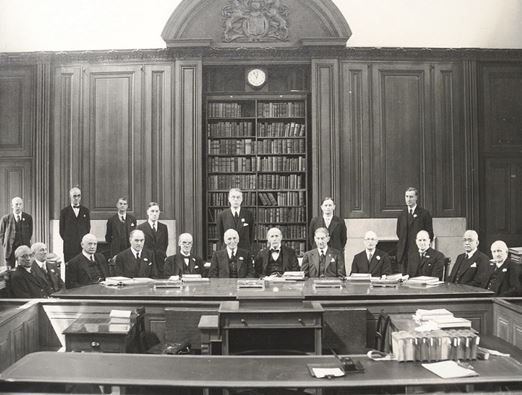Concur (pronounced kuhn-kur)
(1) To accord in
opinion; to agree.
(2) To
cooperate; work together; combine; be associated.
(3) To coincide;
occur at the same time.
(4) To run or
come together; converge (obsolete).
1375–1425: From
the late Middle English concur (collide,
clash in hostility), from the Latin concurrere
(to run together, assemble hurriedly; clash, fight), in transferred use “to
happen at the same time", the construct being con (the Latin prefix variation of cum (with; together)) + currere
(to run). The early meaning in
English was "collide, clash in hostility," the sense of "to
happen at the same time" didn’t emerge until the 1590s; that of "to
agree in opinion" a decade earlier.
Ultimate root was the Proto-Italic korzō,
derived from the primitive Indo-European ḱers (to run). Related forms are the
adverb concurringly and the adjectives concurring and concurrent. Despite the rarity, the verbs preconcur,
preconcurred & preconcurring, and the adjectives unconcurred &
unconcurring are said to exist, at least to the extent no dictionary appears
yet to have declared them obsolete or archaic.
The adjective concurrent is noted from the late fourteenth century
though concurring is said (surprisingly) not to have been in use until the
1630s. The first concurring opinion was recorded
in 1720. The sense "to coincide,
happen at the same time" is from 1590s; that of "to agree in
opinion" dates in English from the 1580s
In praise of the
Privy Council
Concurrent is probably
the most common adjectival form in general use.
Noted since the late 1300s, in the sense of “acting in conjunction,
contributing to the same effect or event", it was from the Old French
concurrent or directly from Latin concurrentem
(nominative concurrens), present participle
of concurrere. The meaning "combined, joint" is
from 1530s and in law, concurrent jurisdiction (that possessed equally by two
courts and if exercised by one not usually assumed by the other) is recorded
from 1767.
Lindsay Lohan and her lawyer in court, Los Angeles, December 2011.
Concur is one of many synonyms for “agree” and the one most favoured by judges on appellant courts to indicate they agree with (or at least acquiesce to) a judgment written by another. That’s good because it means there’s less to have to read. However, some judges prefer to pen their own judgments, helpful perhaps if they wish to explore some aspect of the case not elsewhere mentioned but otherwise a duplication of effort unless their prose serves to render readable what can be turgid stuff. Then there are the dissenting judgments, of interest to academic lawyers and historians and sometimes a source of hope to those entertaining thoughts of an appeal. That notwithstanding, those wishing just to know the state of law with certainty might long for a system in which appellate courts of appeal issued only the majority judgment with the dissenters encouraged to submit essays or letters to the editors of legal journals.
That only one judgment was issued was the most appealing procedural aspect of the Privy Council, until 1968 and 1986 respectively, the highest court of appeal for Australian state and Commonwealth jurisdictions. Properly styled The Judicial Committee of the Privy Council (JCPC), the Privy Council remains the ultimate court of appeal for some British Overseas Territories and Commonwealth countries. Although the Privy Council’s decisions are mostly not binding on the UK’s domestic courts, the rulings are held to be extremely persuasive as other respected tribunals (US Supreme Court, Supreme Court of Canada et al) are regarded. One quirk of the Australian Constitution is that, the 1986 Australia Acts notwithstanding, the High Court can issue a certificate referring certain cases to the council but none has been granted for a century and the court has long made clear there’ll be no more. As a bit of a relic of English constitutional history and the established church, in the United Kingdom, the Privy Council retains appellant jurisdiction some domestic matters:
(1) Appeals from
the Arches Court of Canterbury and the Chancery Court of York in non-doctrinal
faculty causes.
(2) Appeals from
the High Court of Chivalry.
(3) Appeals from
the Court of Admiralty of the Cinque Ports and Admiralty prize courts.
(4) Appeals from
the Disciplinary Committee of the Royal College of Veterinary Surgeons.
(5) Disputes
under the House of Commons Disqualification Act, a role essentially similar to
that the High Court of Australia (HCA) discharges as the Commonwealth’s Court of
Disputed Returns.
Historically, the Privy
Council dealt with cases thus referred without any known demand for multiple
judgments or dissenting opinions; a fine example of judicial clarity and
efficiency and one which judges in other courts never to admire, much less emulate. Despite its exalted place in the legal
hierarchy, the council has been a surprisingly flexible and informal
court. In 1949, it found, on technical
grounds, the Commonwealth of Australia’s appeal in the bank nationalization
case (Commonwealth of Australia v Bank of NSW [1949] UKPC 37, [1950] AC
235; [1949] UKPCHCA 1, (1949) 79 CLR 497 (26 October 1949)) couldn’t proceed
but, because so many people had travelled over ten-thousand miles (17,000 km) to
London (no small thing in 1949), it anyway heard the case and issued what
would have been the substantive judgment.
If ever it’d been prepared to set the example of providing advisory
opinions, the Privy Council would have been the best appellant court ever. Unfortunately, In recent years, dissenting opinions have come to be issued.
Sitting of the Judicial Committee of the Privy Council, 18 June 1946.
M.R Jayaker, Lord Du Parcq, Lord Goddard (Lord Chief Justice), Lord Simonds, Lord Macmillan, Lord Simon, The Lord Chancellor (Lord Jowitt), Lord Thankerton, Lord Porter, Lord Uthwatt, Sir Madhavan Nair, and Sir John Beaumont.






